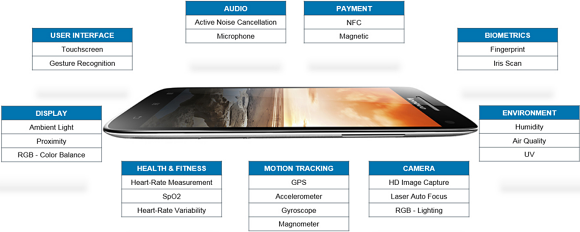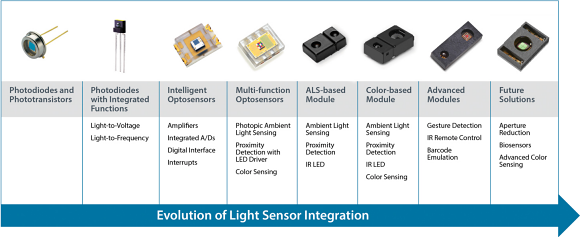
Smartphones now represent 85% of the 1.8B units of world-wide handset shipments and projected to be over 97% of the shipments by the year 2020. This may not be a shocking statistic but given the total worldwide smartphone shipments were less than 200M units in 2009, it clearly indicates the explosive growth enjoyed by the handset industry. The market data indicates that in the last five years, the smartphone compounded annual growth rate was greater than 45%
Many factors have contributed to this tremendous increase in unit shipments but three elements are the cornerstones of the market growth. Firstly, the expanded coverage of mobile networks, and more importantly, the rapid growth in bandwidth have provided the enabling backbone for growth. Secondly, the fundamentals of Moore's Law and the semiconductor market have enabled the net-work growth while also providing communication, computing and storage devices with continually increasing capacity. Thirdly, the smartphone's adoption of sensor technology and complementary software applications save continually improved and expanded their usage-model, while making their interactions with consumers more intuitive, real-time, immersive and simply more beneficial, enjoyable, and valuable to consumers.
As you can see in figure 1 below, the quantity and applications of sensors in smartphones has expanded across a wide range of applications with many new device and applications coming soon (highlight the 'future' sensors/technology in the list). In fact, most consumers are probably not aware of the complexity and quantify of sensors within their phone today. The processing power and never-ending need for handset manufacturers to differentiate and bring additional features and value to consumers been a driving force behind this trend.

Fig. 1: Today's smartphone's sensor.
Next page
Display Sensors
Ideal ambient light sensors (ALS), measure light in a way which approximates the human eye's response to visible light in the in the 390-700 nm wavelength range. This ability to sense light like the human eye (photopic sensing) is critical for accurate light measurements. Ambient light sensors, for automatic display brightness control, was the first optical sensor adopted by handsets to the power savings and improve user experience benefits. With the emergence of smartphones with touchscreen displays, it became critical to disable the touchscreen during call; IR proximity was widely adopted and the most cost effective and reliable solution. The growth in smartphone shipments, along with the essential requirement ambient light sensing and proximity detection solution drove the development of optical modules with ALS and proximity detection solutions optimized for smartphones.
These optical modules typically include the ALS and proximity sensor, IR LED, optical lenses and sophisticated package designs which are optimized for smartphone mechanical design and the display glass characteristics. In addition, the proximity detection in the module solution can be calibrated at the device level which removes the need for end-product calibration as required if a discrete sensor and IR LED are used in the design.
Eventually, systems designers had a need not only for photopic light measurements but also wanted information on the individual red, green and blue (RGB) components. The RGB sensors enabled a more detailed analysis of the light spectrum and color temperature, necessary for delivering the ultimate viewing experience with more vibrant and realistic display images while maximizing energy efficiency. The general evolution of light sensors and integration trends are shown in figure 2 below.

Fig.2: An overview of light sensor progress and integration.
Next page
Advanced Optical Sensors
Optical sensor in smartphones have evolved to meet the demands of system designers to include advanced feature enabling phone features beyond the display. Given the ambient light and proximity modules contain and infrared (IR) LED and associated driving circuitry, technologies which use IR LEDs became a logical target for future integration into smartphone optical modules.
One of these technologies is IR gesture recognition which has delivered enhanced functionality to the smartphone user interface. Gesture detection utilizes photodiodes to sense reflected IR energy from hand movements, then converts this data into physical motion information including: velocity, x, y and z direction and distance. Gesture recognition, and its ability to detect hand movements, provides a touchless, low-power, flexible, customizable and easy to implement user interface. There are many phone usage models where a touchless user interface brings convenience, safety and capabilities benefiting both manufacturers and consumers.
Another technology, which is pervasive in the home, and an ideal functionality for integration into smartphones, is Universal Remote Control (URC). In consumer electronics, the URC is a component of an electronic device such as a TV or DVD player, other home appliance, used to operate the device wirelessly from a short line of sight distance. URC is a convenience feature, and can allow operation of consumer devices that are out of normal reach for direct operation of controls. Advanced optical modules have integrated the functionality to support the implementation of an entire IR remote control subsystem with the addition of only an IR LED and driving FET. This IR LED would typically be placed at the top side of the smartphone to mimic the location and usage behavior with standard remote control. The integration of the URC control functionality into the optical module eliminates the need for a dedicated hardware, such as a microcontroller or FPGA, saving both component costs and space required for the smartphone electronics.
Another technology which can leverage the existing IR LED, and that has been integrated into advanced optical modules for smartphones, is mobeam. Mobeam's patented technology allows smartphones to send pulses of light to the sensor in POS scanners and mimics the black-and-white sequencing of a standard bar code. So, instead of reading the reflection from a printed barcode, laser scanners receive identical information from pulses of light. Mobeam's patented technology sends pulses of light to the sensor in POS scanners and solves the problem that has limited the advancement of mobile couponing, namely that smartphones utilize emissive displays from which a common POS barcode reader cannot capture barcode data. Ams provides devices with IRBeam functionality allowing the device to emulate other optical transmitters or provide advanced signaling using the internal and an external IR LED. A versatile state machine along with bit pattern storage RAM allows for a variety of optical protocols to be generated. The combination of URC and mobeam™ technology and ams sensors will give smartphone makers a single, accurate and powerful integrated solution to participate in the growing mobile couponing and mobile commerce markets.
Next page
Future Outlook
It's anticipated that sensor solution will further evolve ALS or Color-based modules to include native processing capabilities through integration of a microcontroller (MCU) or processor, multiple optical sensors/LED and a variety of interfaces optimized for the target application. Sensor system solutions will provide unique sensing and computation capabilities for the medical, health and fitness markets. The availability of these highly integrated solutions will enable smaller and more feature-rich devices for applications such as heart-rate monitoring, pulse-oximetry and other health/fitness related products.
The high-volume and growth of handsets shipments have also been a driving force for suppliers in advancing the capabilities, reducing component costs, and enabling manufacturing operations to produce devices in excess of 10M units per month. Subsequently, there is no room for any com-promise is component quality, reliability and performance. This creates very demanding metrics for component manufactures and demands precise execution in manufacturing to maintain the highest levels of quality and reliability.
About the Author
Darrell Benke is a Senior Marketing Manager for the Advanced Optical Solutions Division of ams AG with focus on smartphone solutions. He has over 20 years of experience in business development, strategic planning, marketing and semiconductor/system design roles for emerging technologies for semiconductor companies including Texas Instruments, National Semiconductor, Micron Technology and Rockwell International. He has M.S. in Electrical Engineering and VLSI Design from the University of Texas at Dallas and B.S. in Electrical Engineering from North Dakota State University.
Related Stories
NEXT Biometrics to present fingerprint sensor on Smartphone back & other applications
App Suits Those Who Don't Like Sleeping With Their Toys